PROBING THE MIND OF THE WISE OLD OWL
If the four inner corner positions of the Clandon Barrow Lozenge's
central diamond represent stations for the eye of the wise old owl, then the
centre of the diamond represents the owl's mind or "mind's eye".
So, the question might well be asked, what is the old sage contemplating within
its mind's eye?
It would seem that the old owl is concentrating on the Great
Pyramid ratio proportions and how they relate to navigation, as the centre
of the lozenge accentuates coding associated with these items. We have already
touched upon one aspect of this, but will now expand the circle and extend
the St. Andrew's Cross coding to extract further useful numbers.
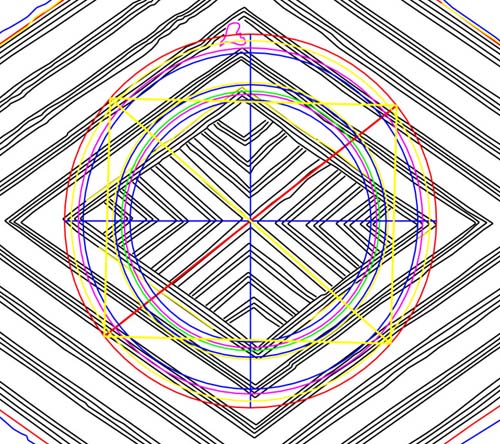
This picture gives some indication of how involved the Great
Pyramid and navigational coding, expanding from the centre of the lozenge,
will become in the final analysis. A sampling of circles is shown that relate
to top and right hand stations, marked by the points of the innermost lozenge
diamond (widthwise & lengthwise). No attempt will be made to enumerate
all the variations in the scale codes extracted, but suffice it to say that
the numbers generated were a part of the fuller navigational and cyclic knowledge.
The Great Pyramid edifice was conceived as a"World Standards" coded
structure for ongoing reference by many cousin civilisations of remote antiquity.
This was the era when the forebears to the European peoples occupied lands
in the Middle East and Near East, before abandoning them to the encroaching
desert and moving to the new verdant territories of Europe (about 5000 BC).
The fullness of the "out of Egypt" codes residing
within the Clandon and Bush Barrow lozenge devices needs to be extracted by
university research teams, using state of the art equipment and high resolution,
perfectly scaled photos of the original artefacts. Pending that future event,
here's an introductory explanation of what we're looking at in the central
"mind of the owl":
The central diamond is 1.701 inches high (lunar code) and 2.3328
inches long (alternative reading 2.333333 inches...dual read in guises of
lunar or overland distances). A diagonal cross (St Andrew's Cross) lies within
the central diamond and the cross arms are angled to comply with the 51.84-degree
face angle of the Great Pyramid, as well as the 311.04-degree code for remembering
the "true" equatorial circumference of the Earth (31104-miles X
4). Variable circle radii are indicated by station points in the 4-quarters
of the lozenge (top, bottom, left & right). As each circle crosses the
St. Andrew's Cross arms, a value is derived at the intersection points and
each value relates to the scaled dimensions of the Great Pyramid or the equatorial
size of the Earth.
Not wishing to complicate matters further, it must be pointed
out that the 311.04-degree angle would also (symbolically) have meant, 309.2727-degrees
and 309.375-degrees, respectively to the ancient user of the lozenge memory
device. These alternative readings (3092.727-miles and 3093.75-miles) represented
45-degrees of equatorial arc under other geodetic systems. There were at least
6 such navigational systems in different number families.
THE SCALED DOWN GREAT PYRAMID CODES.
Where circles cross the 51.84-degree lying vector, which relates to the diagonal
face of the Great Pyramid, they indicate increased scale pyramids. By knowing
the ratio proportion values of the Great Pyramid, between base length, height,
face length and angles, the lozenge owner could make a series of very useful,
scaled down ratio calculations. These were done within a framework of varying
formulas, which viewed the Great Pyramid proportions in marginally different
ways, according to several number families. Here are the more important examples
of "ways to read" the pyramid's face diagonal length:
- The Great Pyramid face diagonal length could be read by ordinary trigonometry.
Therefore: 756 feet ÷ 2 = 378 feet ÷ 51.84 COS
= 611.7894615 feet (to an apex position where all lines coming up the faces
intersect).
- The Great Pyramid face diagonal length could be read by PHI (1.6180339 to
1). Therefore: 756 feet ÷ 2 = 378 feet X 1.6180339 = 611.6168142
feet.
- The Great Pyramid face diagonal length could be read by "rounded PHI"
(1.62 to 1). Therefore: 756 ÷ 2 = 378 feet X 1.62 = 612.36 feet.
- The Great Pyramid face diagonal length could be read as an expression of
360-degrees ÷ 58.333333 = 6.171428572 (X 100) = 617.1428572
feet. The base perimeter of the Great Pyramid @ 3024 feet ÷
51.84-degrees = 58.333333. This was a "7" series way of reading
the pyramid, which symbolically viewed its face angle as 51.42857143-degrees
(360 ÷ 7).
Essentially, the Great Pyramid represented a large static model and assumed
several slightly varied mathematical assignments, depending upon what type of
calculation (and in what number family) the scientist/ mathematican wanted resolution
of a mathematical problem...lunar, solar, navigational, etc..
THE MAIN READING METHOD FOR THE GREAT PYRAMID.
Under the most basic calculation model, the Great Pyramid was seen to have
a base length of 756 feet, a face diagonal length to a symbolic apex of 612.36
feet and an overall vertical height to a symbolic apex at 480 feet. In this
calculation scenario it's face degree angle was considered to be 51.84-degrees
(literal). The Great Pyramid never had a capstone on top, but was built with
a flat floor altar at 453.6 feet of vertical height. The importance of this
most standard mathematical model related to the exact numbers and ratios it
generated.
- To find the length of the face (612.36 feet) divide the base length (756
feet) by 1.23456789. Therefore: 756 ÷ 1.23456789 = 612.36 feet.
- Another way of finding the side face length was to multiply half the base
length by 1.62. Therefore: 378 X 1.62 = 612.36 feet.
- To find the (symbolic) vertical height (480 feet) divide the base length
(756 feet) by 1.575. Therefore: 756 ÷ 1.575 = 480 feet.
- To find the height of the altar floor divide the base length by 1.66666666.
Therefore: 756 ÷ 1.6666666 = 453.6 feet.
For those who wish to experiment mathematically with the above "sample"
circle codes shown in the central diamond of the lozenge, their inch radii are:
.756, .792, .81, .8505, .864, 1.05, 1.08, 1.125 and 1.1664.
THE CENTRE DIAMOND REGION OF THE
BUSH BARROW LOZENGE.
As stated, archaeologist's John Coles and Joan Taylor
suggested that the Bush Barrow and the Clandon Barrow lozenges were probably
fabricated by the same artisan (See The Wessex culture: a minimal view,
Antiquity, XLV, 1971, pages 6-13). This contention might well be supported
by geometric coding similarities found in the central sections of both lozenges,
each showing a St. Andrew's Cross, with arms lying at 51.84 and 311.04-degrees,
respectively. Let's enumerate the "in common" design features of the
two gold lozenges.
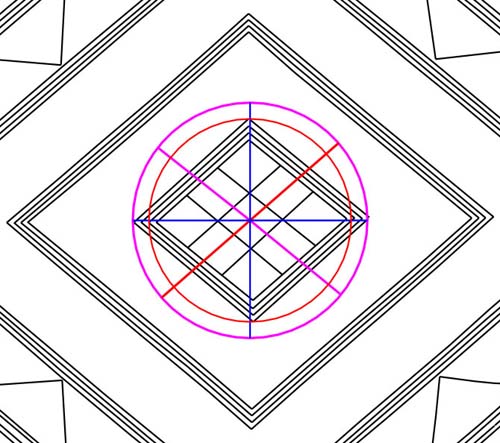
The Bush Barrow Lozenge centre section, based upon an accurately scaled
drawing of the lozenge done within the exacting confines of AutoCAD. Scaling
was completed by reference to dimensions supplied by Mr. Paul Robinson, Curator
of the Devizes Museum, Wiltshire, England.
- The magenta circle has a diameter of 1.701 inches. It touches the end points
of the centre diamond to the left and right. This is exactly the same size
as the circle that touches the end points of the Clandon Lozenge's central
diamond, top and bottom. Both lozenges are accentuating the same lunar code...1701-days,
which is 1/4th of the lunar nutation cycle of 6804 days.
- The red circle is 1.466666 inches in diameter, which has no affiliation
to the lengthwise code of the Clandon lozenge's centre diamond (2.3328 inches).
The 1.466666 inch diameter is 1/3rd of 4.4 inches and a part of the "11"
series navigational system.
- The red line running diagonally up to the right is on an angle of 51.84-degrees...the
same as the inscribed line on the Clandon Lozenge's centre arm of the St.
Andrew's Cross.
- The magenta line running diagonally up to the left is on an angle of 311.04-degrees...the
same as the inscribed line on the Clandon lozenge's centre arm of the St.
Andrew's Cross.
- The same codes apply...311.04-degrees minus 51.84-degrees = 259.2-degrees.
The Heel stone outer face at Stonehenge sits 259.2 feet from site centre at
an angle of 51.84-degrees to its south facing side. The sum of 311.04-degrees
is 360-degrees minus 48.96-degrees. If the value of 48.96-degrees is added
to 51.84-degrees, then the total is 100.8-degrees. The value of 100.8 feet
was 1 second of Earth equatorial arc under the Great Pyramid "6&7"
geodetic assignment, which sized the Earth to 3024 X 43200 feet (or 130636800
feet...24741.81818-miles). At Stonehenge's Sarsen Circle inner rim one of
the cross measurements between lintels was 100.8 feet, coding 1-second of
arc.
THE WISE OLD OWL OF BUSH BARROW.
The Bush Barrow Lozenge, although larger than the Clandon Barrow Lozenge is
of a simpler design, with a lesser number of inner compartments. Let's apply
the "owl eyes" circle geometry, as found upon the Folkton Drums artefacts,
to the Bush Barrow Lozenge...as,"out of the mouths of two or three
witnesses shall every word be established".
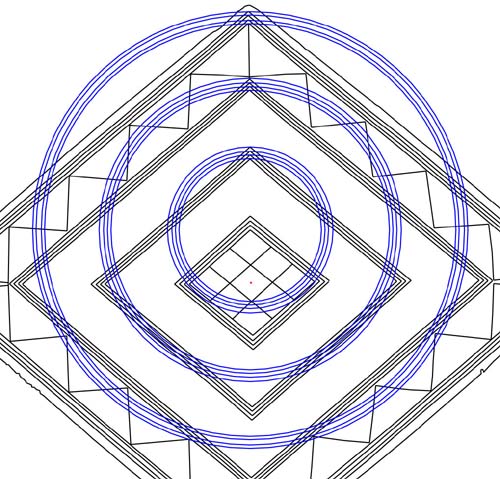
Restoring the vision of the old owl of Bush Barrow. Here are
the circle codes expanding out from the inner point, upper section, of the central
diamond. All radii listed are in British Standard inches:
- 2.4 ("6" series, navigation, Great Pyramid), 2.3625 (lunar), 2.304
(lunar, navigation), 2.268 (lunar, Great Pyramid).
- 1.666666 (3,4,5 triangulation), 1.6180339 (PHI), 1.575 (reed, stadia, Great
Pyramid), 1.536 (navigation, lunar).
- .913125 (solar year), .864 (navigation, Great Pyramid, diameter of Sun),
.825 "11" series navigation), .7854 (PI).
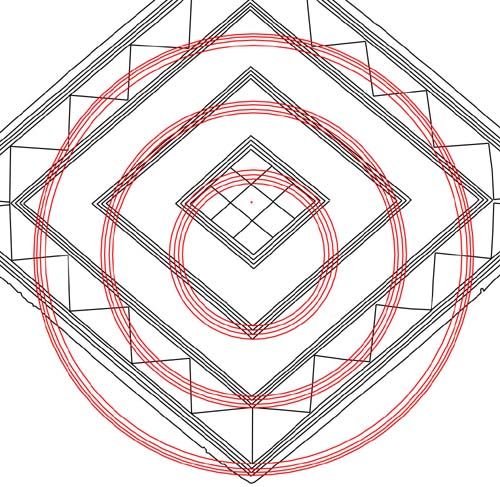
Here are the circle codes expanding out from the inner point, lower section,
of the central diamond. All radii listed are in British Standard inches:
- 2.43 (lunar), 2.4 ("6" series navigation, Great Pyramid), 2.3625
(lunar), 2.304 (navigation, lunar, Great Pyramid).
- 1.6875 (lunar), 1.65 ("11" series navigation), 1.6 ("8"
series, compass),1.5625 ("5" series, compass, navigation).
- .93312 (navigation, Babylonian Talent), .88 ("11" series navigation),
.833333 (3.4.5 triangulation), .7857 (PI).
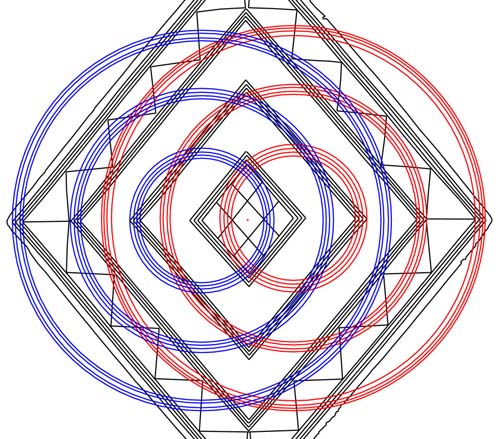
The Bush Barrow Lozenge picture turned 90-degrees anti-clockwise. This is
the result of restoring the "owl eyes" circle geometry as it relates
to the top and bottom sections of the lozenge.
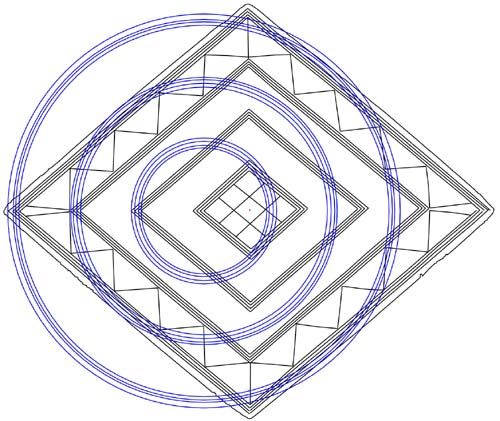
Here are the coded circles expanding out from the inner point, left section,
of the central diamond. All radii listed are in British Standard inches:
- 2.916 or 2.9166666 (lunar, navigation), 2.835 (lunar, Khafre Pyramid), 2.8
(calendar), 2.75 ("11" series navigation).
- 1.98 ("11" series navigation), 1.944 (lunar), 1.89 (Great Pyramid,
navigation, calendar), 1.833333 ("11" series).
- 1.08 (lunar, precession, navigation), 1.0909090 ( "6&7" Egyptian
Royal Cubit, Great Pyramid, navigation).
- .972 or .97222222 (lunar, navigation), .93312 (lunar, navigation, Babylonian
Talent @ 933120 grains).
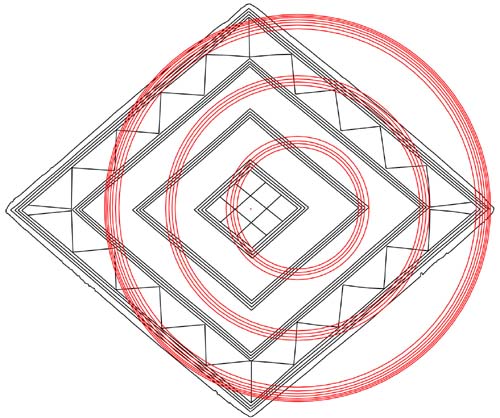
Here are the coded circles expanding out from the inner point, right section,
of the central diamond. In the outer set of pattern line points the the artisan
who made the lozenge appears to have added extra codes by extending some lines
and letting others fall short during incising. As a consequence, 6 codes will
appear in the list for this region instead of 4. All radii listed are in British
Standard inches:
- 2.88 (Great Pyramid, Menkaure Pyramid, Stonehenge, navigation), 2.857142857
("7" expression within 360-degrees).
- 2.835 (Khafre Pyramid perimeter, Octagon of Newark, lunar), 2.8 (calendar,
28 lunar mansions).
- 2.7216 ("6&7" series navigation), 2.66666 (compass)
- 1.96875 (lunar, Beqa grain weight standard), 1.92 ("6" series
navigation),
- 1.875 ("11" series navigation, lunar, compass), 1.82625 (solar
year, day count between equinoxes).
- 1.0666666 (conversion ratio 15/16ths), 1 (inch reference), .96 ("6"
series navigation), .913125 (solar year).
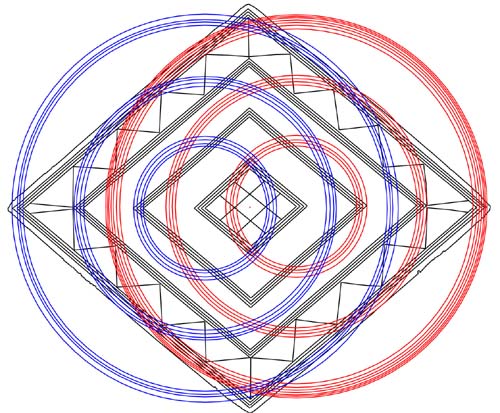
The old owl of Stonehenge slept at Bush Barrow for several millennia's,
but is now awakened anew...Like the wise owl of Clandon Barrow, its reputation,
too, was much maligned and its profound wisdom brought into question by its
enemies. The old sage is restored to its perch, with its eyes firmly fixed on
the overabundant rodent population.
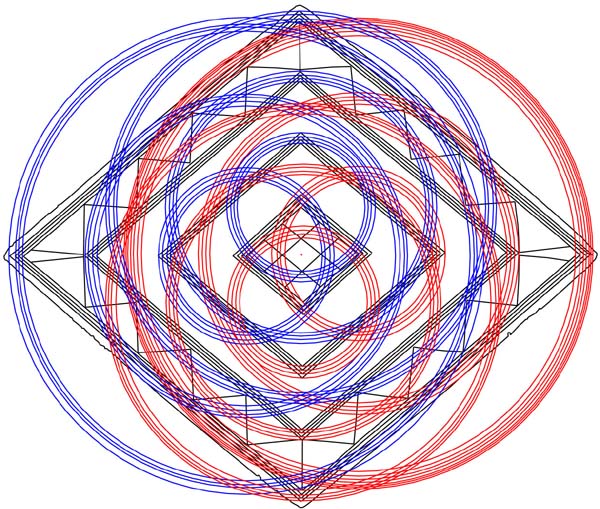
The totality of codes expanding outward into the four quadrants of the Bush
Barrow Lozenge. Each dimension listed was once absolutely essential for the
optimisation of society and the maintenance of the concept of civilisation.
Every circle radius or diameter built into the Bush Barrow Lozenge has a pedigree
back to the length, angle and area codes found upon the "World Bureau of
Standards" structures of the Giza Plateau.
These numerical values were used for tracking the cycles of the sun, moon
or planets and maintaining the very accurate Sabbatical Calendar. The values
were used in remote antiquity for safe traversal of large oceans or the circumnavigation
of the world to set up mining colonies on all continents. Ancient navigation
was so advanced that it could be undertaken according to 5 major numerical systems,
with a 6th system, based upon PHI, available for specialised scientific calculations.
The lunar, solar and navigational values were used within the weights, measures
and volume standards of all the "cousin"great civilisations, extending
from Sumeria and Babylon to Britain. The selfsame numerical values are found
encoded, by measurement and angles, between cairn markers within the long valleys
or over the high hills of the most distant lands and far Isles of the world.
This was done, religiously, in every clime at great effort ... lest strangers
in new found homelands forget the foundation principles of civilisation or lose
the ability to retrace their steps back to the old countries of their forebears.
Sadly, all of this was wrestled, violently, from our grasp many centuries ago
and supplanted by something of about the same intellectual composition as pig
manure.
There remain many codes yet to extract from both lozenges and the foregoing
series of articles is by no means definitive. This body of information should
be sufficient to get researchers started in the process of decoding other patterned
goldwork of ancient Britain. The key to it all lies in an understanding that
the British Standard inch is well over 8000 years old...after that it's
simply a matter of making precise measurements to extract the encrypted numerical
values within these artefacts.
CONTINUE








